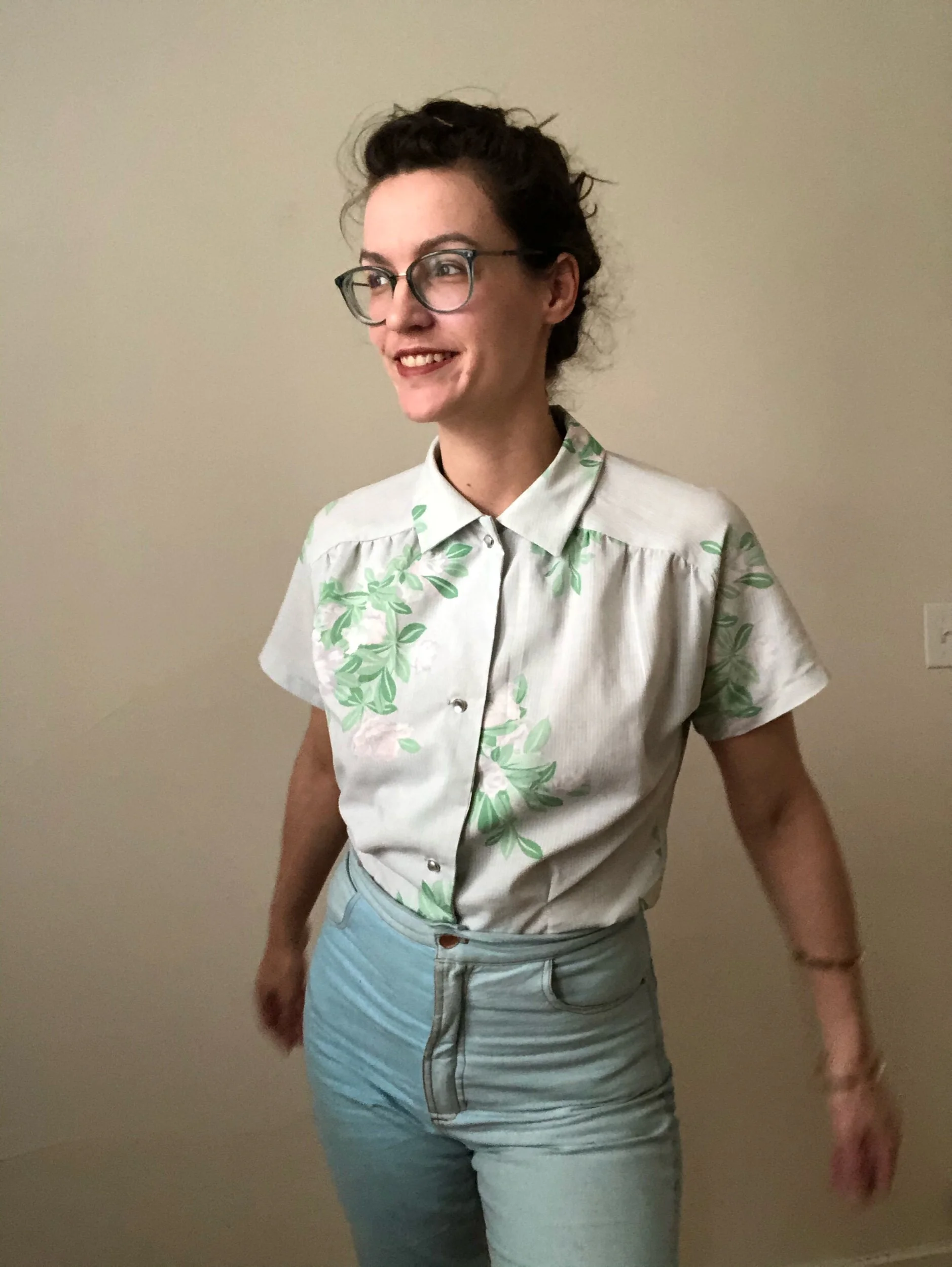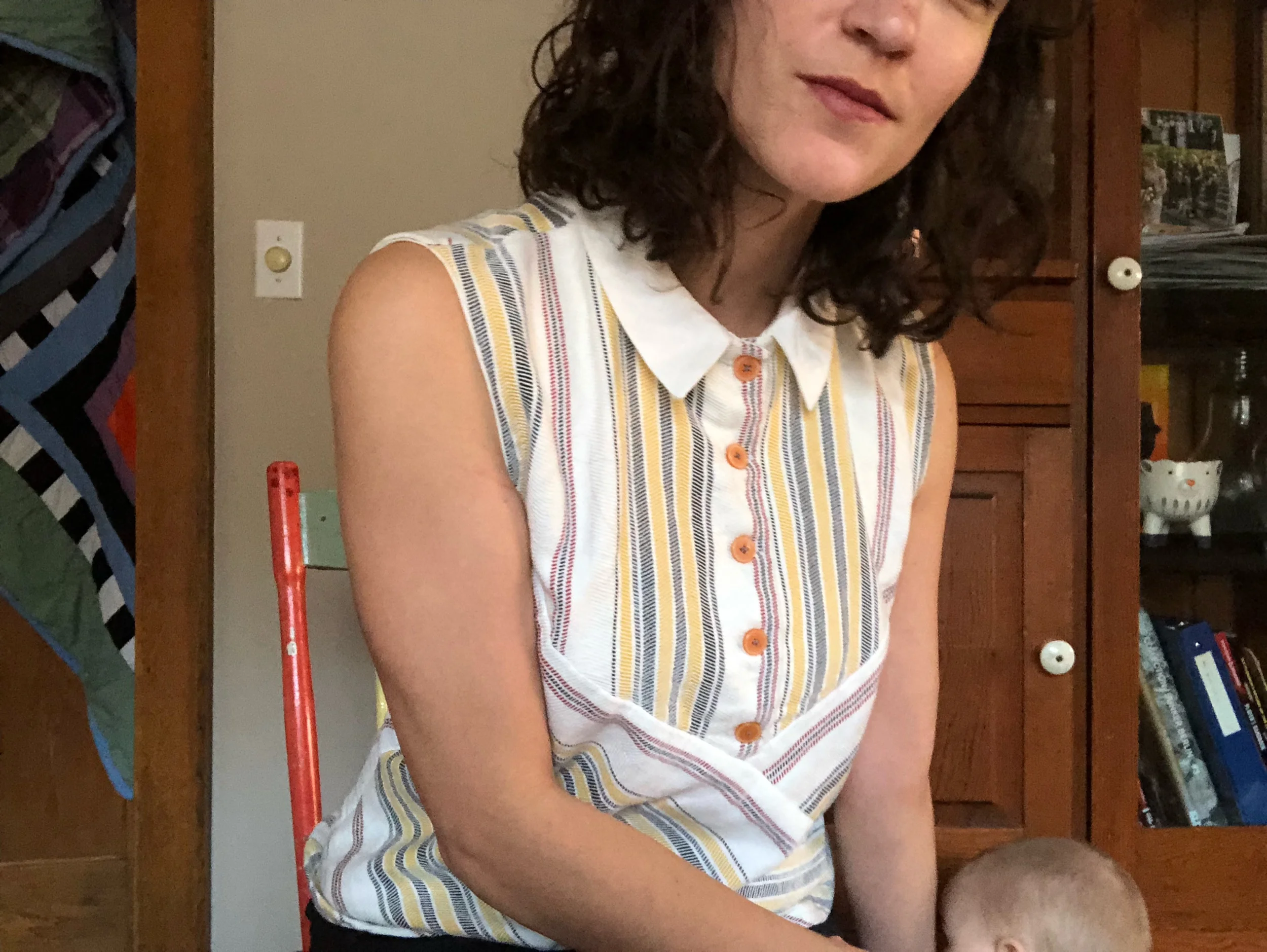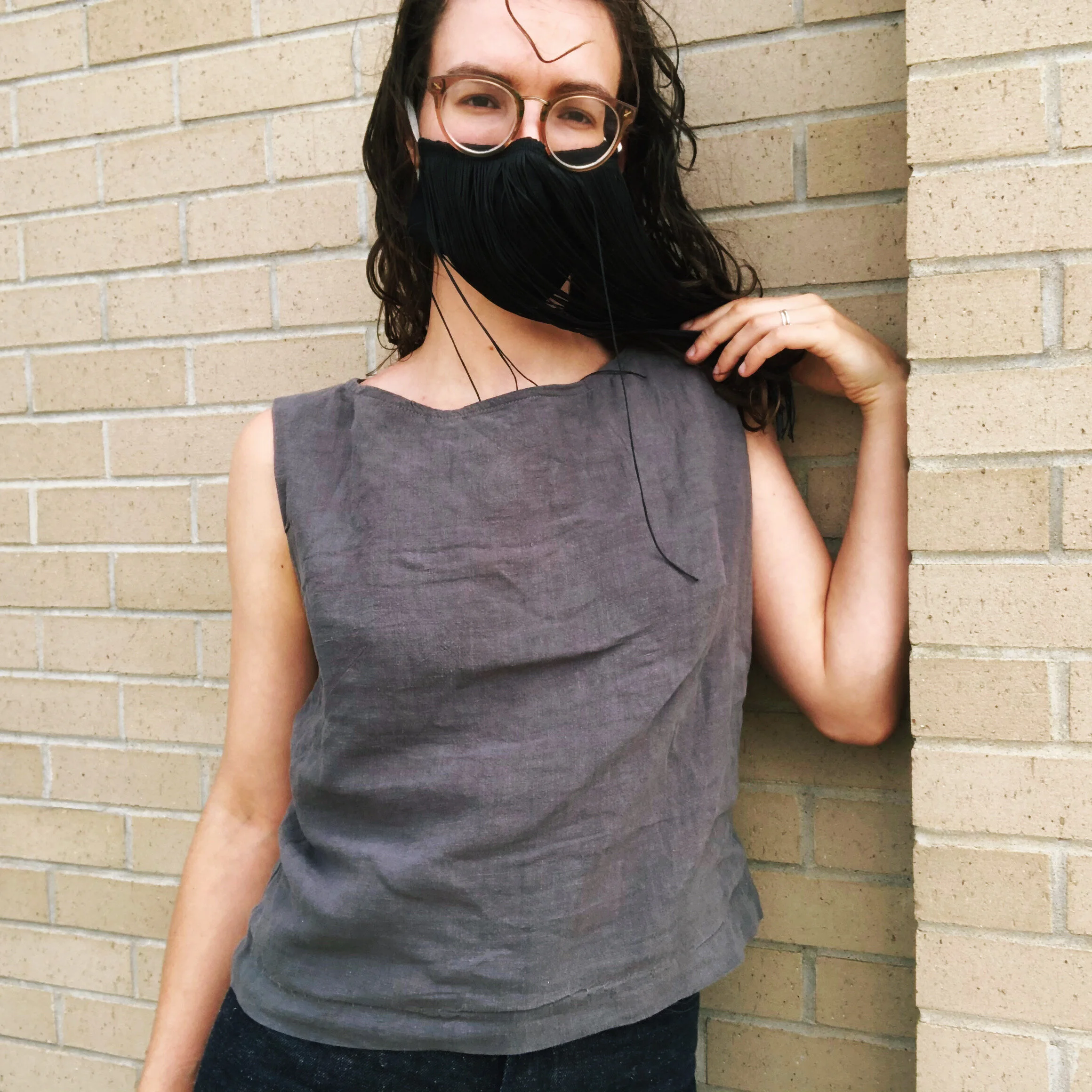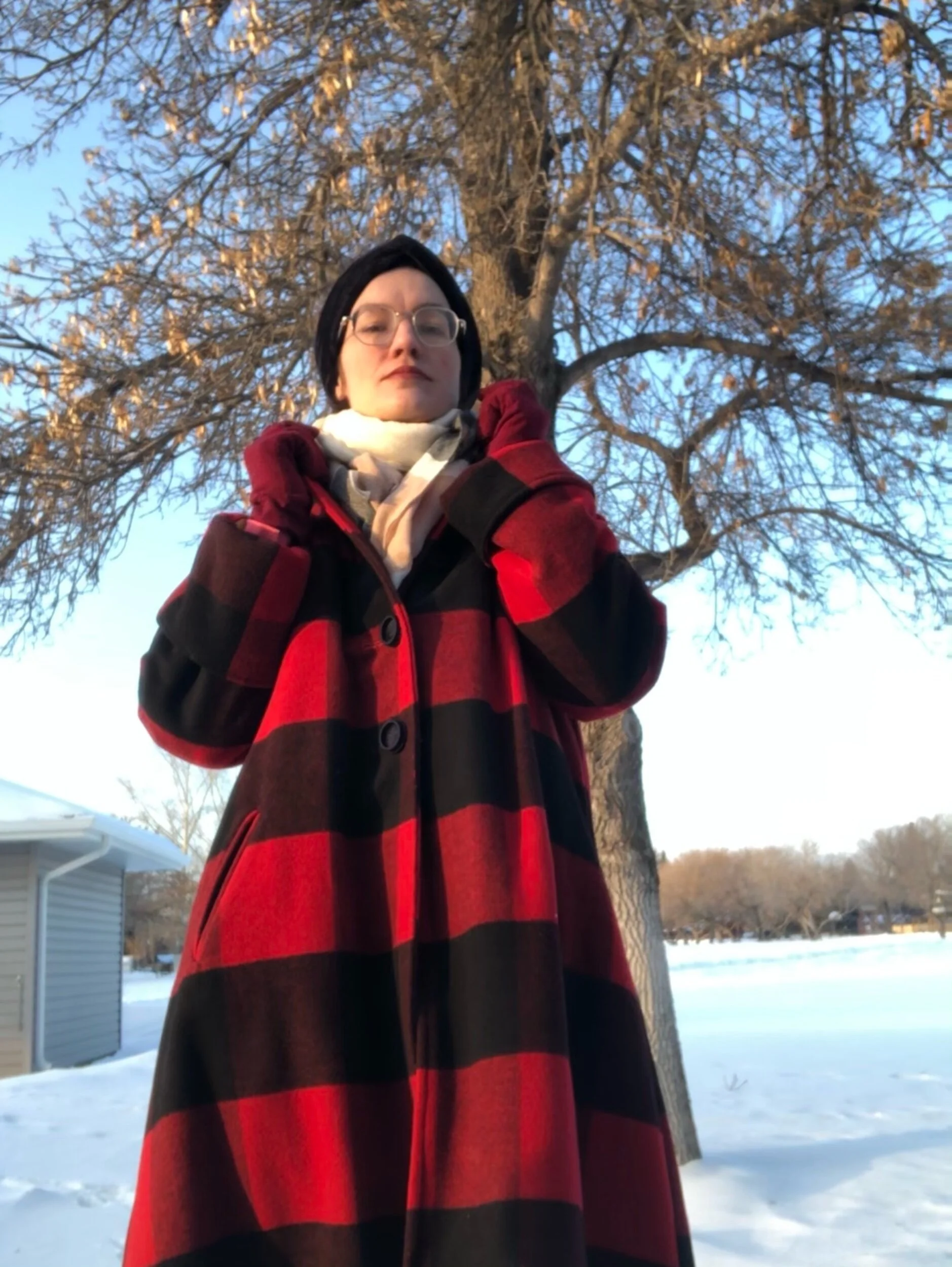WFH shirt: 1950s overblouse
I was planning to make a silk noil top for a cute work shirt, but that got nixed with the COVID-19 state of emergency and transition to work from home. But I remain largely a “get dressed” person, with jeans and collared shirts, if possible. So I moved onto the idea of making up a comfier, more casual, but still office-friendly top.
This particular 50s pattern (Simplicity 2652) caught my eye both because of the complete perfect cuteness of 50s patterns and because it was in my correct bust size. No grading, no problem.
To be specific in what drew me to it: pleats and a box dart in back for soft femininity, an open collar walking the golf dad vibes line, and a partial placket, giving me something brand new to try.
just clipping on an earring
I whipped out the shoulder tracing I tried out for the black bean shirt, and this time the results were more clear: The shoulder slope would be just dandy. The bust line looked like it would be OK too, to my surprise.
The plaid was an obvious choice for this: soft cotton, of unknown vintage, purchased second hand from a student clearing house on Kijiji. Yarn dyed, fall colours but also ~ colours I like on myself ~ and again, so soft. Echoes of the pattern art’s back view shirt. I had to be careful with cutting because some spots haven’t aged as well, and there’s a tiny hole on the front that I’m going to have to darn. I can’t believe I didn’t notice it when cutting! Or maybe I created it while sewing? WHO KNOWS.
Cut directly from the pattern pieces, as the previous owner had deffo used them too and it gave me motivation to archival tape some of the tears, plus, no need to grade nor alter shoulder slope so tracing seemed unnecessary.
Thank goodness I’m not fussy about matching plaids, because that was not gonna happen. Very shifty stuff, and I didn’t’ even manage to stay on grain properly. This has caused the one thing about this shirt that really niggles at me, which is that at the bottom front there’s a bright white line that’s off kilter and gets cut off by the band and just draws your eye all wrong! Next time I’ll try pinning along the plaid lines along the way to keep things a little more even.
really do like the back, and really if there’s one place to get your pattern matching right it’s here, right?
back floated down a bit - still cute but slinky
I started out feeling pleasantly surprised at how clear the instructions were for something of this era, but after the first part of the placket/facing changed that position. I still muddled through. Honestly I couldn’t really understand the pattern piece at first since they’re cut-on and folded to create the triangle tip so I just had to re-cut one of the plackets since they weren’t matched at all. I should have re-cut them both, but I was picturing it buttoning up all the way and the button placket being usually hidden. But visually, I don’t really notice the mess up that much so I’m OK with it.
face mask for good measure lol - you can see the bottom bit that’s bugging me quite clearly here
I’m not entirely sure why I kept picturing lots of buttons up the front but the pattern doesn’t call for that and the illustration doesn’t look like that. And I didn’t go for it because the clean looking placket was what I was after, I just thought it had like a hidden placket? The pattern does suggest you could make a thread loop and hook to close it but that just doesn’t seem worth the effort.
Oh well, cazj open collar vibes for days.
Pleats and cuffs were straight ahead as I’ve done those before, and I had the presence of mind to add stays to the shoulder seams to compensate for the somewhat loose weave. Which made me feel the growth in sewing experience - as you get comfortable just making the right call rather than anything written. The stays were just bits of selvedge.
I actually meant to show u the buttons but here for the drama instead hello
The collar is without a stand and without a back facing and I could not, for the life of me, make out what the instructions wanted me to do to attach and finish the area. Far too many steps in one paragraph/diagram. But! I have been picking up all kinds of sewing resources for some time, and turned to the Reader’s Digest Book of Sewing Techniques, which had a spread on just this situation. I followed those instructions, but had already started on the pattern instructions, so there is one small section of inner back neck that is not nicely finished. I did not opt to fix it as it isn’t physically irritating so it’s all good, ultimately.
Basically, the key to getting it all covered is to clip up to the stay stitching so where the facing ends you can switch to having the collar cover the ends. In my case pin the shit out of it then handsew. It looks real nice when all told.
Finished the facing edges with a single turn under secured with a zig-zag stitch. Hand sewed in a tag. Tack the facings down by hand to maintain invisibility.
The sleeves were fun, with lots to ease in at the top and gathers at the bottom. I did the most lovely sleeve cap I’ve ever done, really steamed out the excess to a beautiful degree, but it was inside out. The following effort was fine, if not as perfect. But correct side out. So.
The sleeve cuffs are so tiny - I actually have to use the button to get the arms on and off. I was even a bit nervous they’d be too tight to wear but work out juuuuust fine. The placket is also faced, which was easy but didn’t come out super cleanly and requires tacking to not have it flappin’ all over the place. MBY not my fav technique.
I do find that the shirt wants to slink back over time, probably due to the excess weight at the back, which leads to a bit of bagginess where the back gathers are happening at the band. I don’t love that but it’s not a deal breaker. I might take a tiny bit of length out if I were to make this again? Which, I love the look of the back otherwise so I might just want to use that idea again.
shirt falling back
I didn’t (gasp!) finish the seams as I went along. I kind of decided I’d just hand overcast, so that’s where I’m at. Hand overcasting an otherwise-finished shirt. And darning a tiny hole on the front.
The buttons are all from the random button collection. The front green one is really a perfect match for these colours and I’m extremely into it.
Pattern: Simplicity 2652 circa 1958
Size: Bust 36
Measurements: Bust 36, waist 30
Next time: Pin plaids along key lines to keep everything lined up. Check the sewing guidebooks before launching into confusing instructions! Consider shortening the back.
underlit and i love it
À little mend
The old fabric used here was delicate and thinning off the hop and I quickly found a little hole - reweaving to the rescue!
















